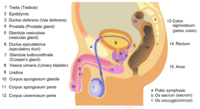
Photo from wikipedia
Structures responsible for the emission phase of ejaculation are the seminal vesicles, the most distal part of the cauda epididymidis and the newly characterized prostate excretory ducts. The emission phase… Click to show full abstract
Structures responsible for the emission phase of ejaculation are the seminal vesicles, the most distal part of the cauda epididymidis and the newly characterized prostate excretory ducts. The emission phase is mainly regulated by the sympathetic nervous system through alpha1-adrenergic receptor activation by noradrenaline at the targeted organs. Benign prostatic hyperplasia (BPH) treatment with alpha1A-adrenergic antagonists such as tamsulosin is known to result in ejaculation dysfunction, often leading to discontinuation of therapy. Mechanisms of this disturbance remain unclear. We established a rodent model system to predict drug responses in tissues involved in the emission phase of ejaculation. Imitating the therapeutic situation, prostate ducts, seminal vesicles and the distal cauda epididymal duct were pre-incubated with the SMC-relaxing BPH drugs tadalafil, a novel BPH treatment option and tamsulosin in an ex vivo-time-lapse imaging approach. Afterwards, noradrenergic responses in the relevant structures were investigated to simulate sympathetic activation. Noradrenaline induced strong contractions ultimately leading to secretion in structures without pre-treatment. Contractions were abolished by tamsulosin in prostate ducts and seminal vesicles and significantly decreased in the epididymal duct. Such effects were not observed with tadalafil pre-treatment. Data visualized a serious dysfunction of each organ involved in emission by affecting alpha1-adrenoceptors localized at the relevant structures, but not by targeting of smooth muscle cell-localized PDE5 by tadalafil. Our model system reveals the mechanism of tamsulosin resulting in adverse effects during ejaculation in patients treated for BPH. These adverse effects on contractility don't apply to tadalafil treatment. This new knowledge translates directly to clinical medicine.
Journal Title: Reproduction
Year Published: 2022
Link to full text (if available)
Share on Social Media: Sign Up to like & get
recommendations!